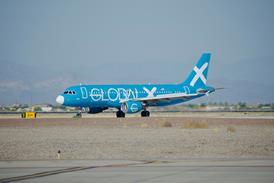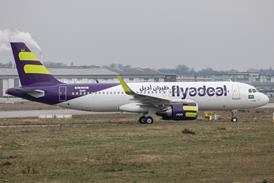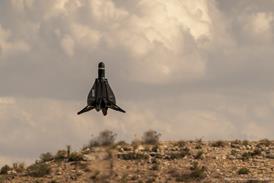Spanish flag-carrier Iberia has yet to decide whether to repair the Airbus A340-600 which overran at Quito after striking the runway so hard during landing that damaged sensors ultimately impeded the aircraft’s deceleration.
Flight IB6463 suffered vertical forces of 3g on touchdown after the crew deliberately descended below the glideslope in a bid to use the entire 3,120m (10,240ft) length of Quito’s runway 35.
On the day of the accident, 9 November last year, the runway surface was wet and weather data indicated a 6kt tail-wind, increasing the distance needed for aircraft to stop.
The normal instrument landing system glideslope leads to a threshold displaced by 510m. By dipping below this glideslope, and performing a visual approach using precision approach path indicator lights, the crew aimed to gain additional landing distance by touching down ahead of the threshold.
But at the decision height of 652ft, after an initially stable approach, the autopilot was disconnected and the captain put the aircraft into a steep descent to reach the lower glide path.
Between 450ft and 150ft the aircraft descended at more than 1,400ft/min, triggering ‘sink rate’ warnings from the ground-proximity warning system.
Information from the flight-data recorder, and released by Ecuador’s investigation agency, shows that the captain gave only “transient” pitch-up commands as the jet neared touchdown and that the A340 was still descending at 1,100ft/min when it hit the runway.
Such was the impact of the 249t aircraft that both pairs of forward tyres on the main landing-gear burst under the enormous force of the articulated bogies’ whipping onto the surface, resulting in the loss of auto-brake.
Crucially, the impact also damaged the proximity sensors which the A340’s flight-control logic uses to determine that the aircraft has landed.
Although the crew reduced the throttle levers to idle, and the ground spoilers deployed, the aircraft’s engines stayed at flight-idle power and the thrust-reversers did not activate, because the damaged sensors failed to register that the A340 was on the ground.
The crew applied full manual brakes 5s after the touchdown and kept braking through the landing roll. Despite the A340’s having 2,920m of runway available to stop, the wet conditions and the aircraft’s configuration, plus the burst tyres, meant it could only maintain deceleration of 0.15g – not enough to prevent its overrunning the end of the runway at 85kt and sliding 200m before coming to a halt.
None of the 333 occupants was injured but the jet suffered serious damage to its undercarriage and engines and the hull obstructed operations at Quito for three weeks before engineers removed the aircraft.
A spokeswoman for Iberia says the jet remains in Quito and the airline has “still not decided” whether it will be repaired and, if so, when it might return to the fleet.
Ecuador’s Junta de Investigaciones Aereas is continuing with its inquiry. But Airbus has already reminded A340 crews to follow standard operating procedures and to execute a go-around if the approach becomes unstable.
Source: flightglobal.com's premium news site Air Transport Intelligence news
Source: FlightGlobal.com























